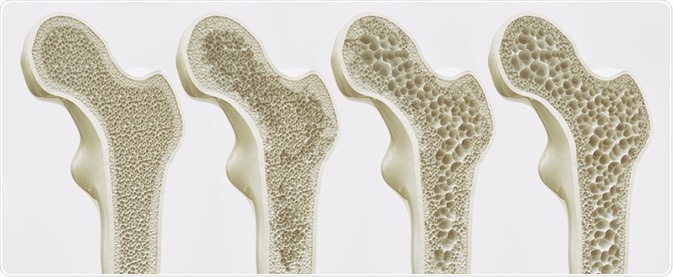methotrexate how long
Opioids are profoundly addictive and highly potent analgesics. Narcotics such as opioids produce a euphoric feeling, and this leads to an increased probability that individuals will keep using them despite adverse outcomes; Opioid Use Disorders are the specific term used to describe this condition.
.jpg)
Image Credit: Victor Moussa/Shutterstock.com
Opioid Use Disorders is a fundamental relapsing and chronic illness related to a significantly high level of morbidity and mortality. A debilitating consequence of Opioid Use Disorders is bone disorders such as osteoporosis, osteopenia, and osteomyelitis.
Both osteopenia and osteoporosis are characterized by low bone mineral density, whereas an infection describes osteomyelitis in the bone.
What are the signs and symptoms of opioid addiction on bones?
The prominent symptoms that appear in a person abusing opioids are osteopenia and osteoporosis. Osteopenia and osteoporosis represent the state of bone loss, which, if not managed, can lead to an increased risk of fracture, pain, buy cheap zyprexa canadian pharmacy no prescription stooped posture, and height loss.
A person addicted to opioid medications is more susceptible to the decreased bone mineral density in the trabecular and lumbar vertebrae. Bone mineral density is found to be less than average in the case of osteopenia, but it becomes less in case of osteoporosis.
The other exasperating and prominent symptom related to the bone in an opioid-addicted person is increased risk of vertebral osteomyelitis or infection in the vertebrae. Vertebral osteomyelitis leads to moderate to severe back pain, fever, pain in the arm or leg, muscle spasm, difficulty in walking, and kyphosis (abnormal curvature of the spine).
How is opioid addiction in bones diagnosed?
The diagnosis of Opioid Use Disorders is very crucial. It is done based on "Diagnostic and Statistical Manual of Mental Disorders, Fifth Edition" (DSM-5) diagnostic criteria that were given by the American Psychiatric Association.
To make a confirmed diagnosis, the patient should meet at least two out of 11 criteria of DSM-5 within 12 months.
A clinician makes the diagnosis by evaluating the history, symptoms, and applying the clinical information to assess the problematic repetition of opioid use.
The 11 criteria of DSM-5 are listed below:
- Continued use of opioid despite worsening psychological and physical health
- Continued use leading to interpersonal and social consequences
- Decreased recreational or social activity
- Difficulty in fulfilling the duty at home or work
- Taken opioid more than needed
- Substantial time is spent on the activities to obtain opioids or recover from its effects.
- Possess craving or urge for opioid
- Exhibits withdrawal
- Continued use in the situations in which it can prove as physically hazardous
- Exhibits tolerance
- Unable to lower the amount used
What are the causes of opioid addiction on bones?
The most important causes of detrimental effects arising due to chronic consumption of opioids are hyperprolactinemia and hypogonadism. The long-term endocrine effect of opioid is manifested as the suppression of the hypothalamic-pituitary-gonadal axis that ultimately leads to hypogonadism, which is a risk factor for osteopenia and osteoporosis.
Both males and females are equally susceptible to this condition. The impaired hypothalamic-pituitary-gonadal axis also leads to an increased prolactin hormone, which is another risk factor for osteoporosis.
Chronic opioid use also impairs osteoblast, which, in turn, prevents new bone formation.
What are the treatment options for opioid addiction on bones?
One of the best treatment methods for opioid addiction is the gradual reduction of opium consumption and completely stopping after that.
The person can switch to other pain management options like non-steroidal anti-inflammatory drugs, anti-convulsants, and anti-depressants that are less associated with the risk of bone loss.
Opioid addiction can be treated with drugs that help reduce the cravings in opioid-addicted individuals. Non-pharmacological therapies include calcium and vitamin-D supplementation, radiofrequency nerve ablation, weight-bearing exercises, limitation of caffeine/alcohol.
For the treatment of osteoporosis, various pharmacological medications and hormone therapy are available that provide substantial benefits. For the treatment of vertebrae osteomyelitis, systemic antibiotic treatment is used.

Image Credit: Crevis/Shutterstock.com
Sources
- Hser, Y. I., et al. (2017). High mortality among patients with opioid use disorder in a large healthcare system. Journal of addiction medicine, 11(4):315.
- Robinson, S. M., et al. (2016). The classification of substance use disorders: Historical, contextual, and conceptual considerations. Behavioural Sciences,(3):18.
- Dydyk, A. M., et al. (2020) Opioid Use Disorder. InStat Pearls. Stat Pearls Publishing. Tu, K. N., et al. (2018). Osteoporosis: a review of treatment options. Pharmacy and Therapeutics, 43(2):92.
Further Reading
- All Opioids Content
- Opioids – What are Opioids?
- Opioid Pharmacology
- Opioid Uses
- Opioid Side Effects
Last Updated: May 27, 2020
Source: Read Full Article
